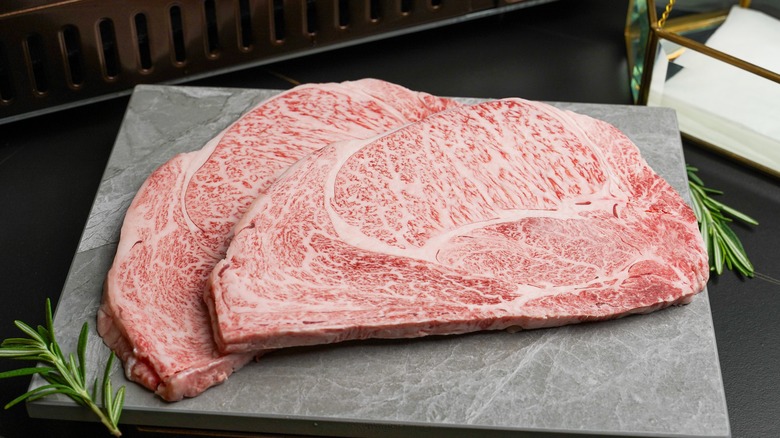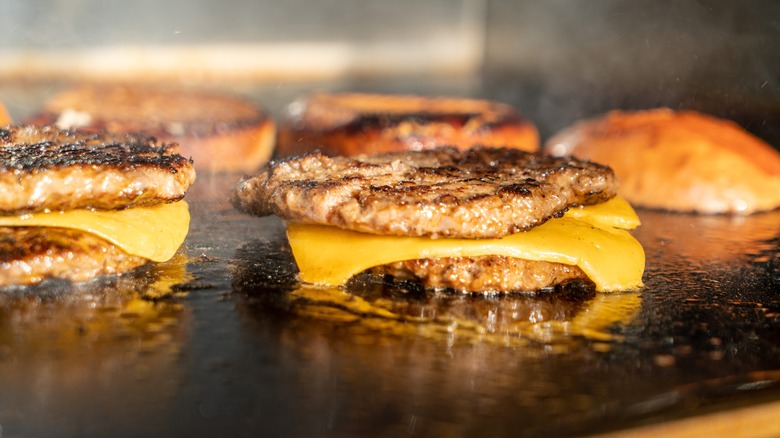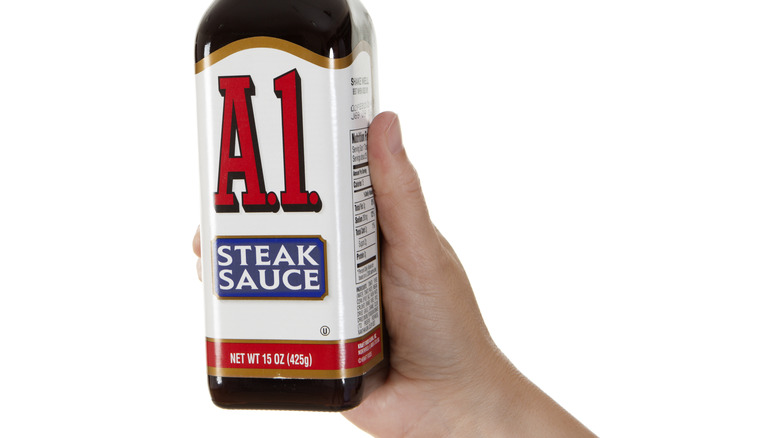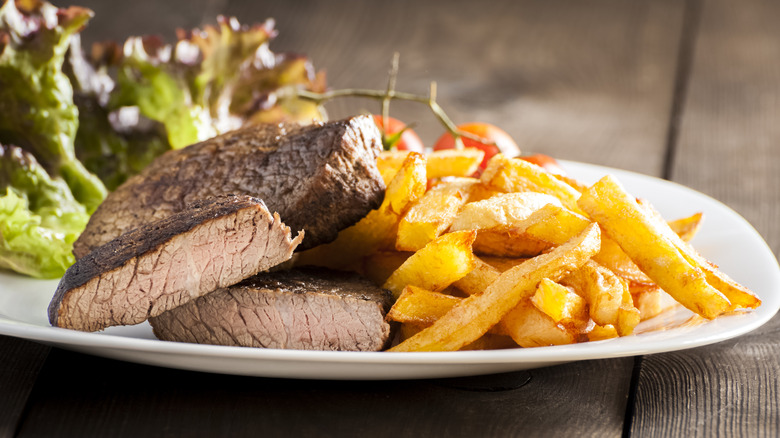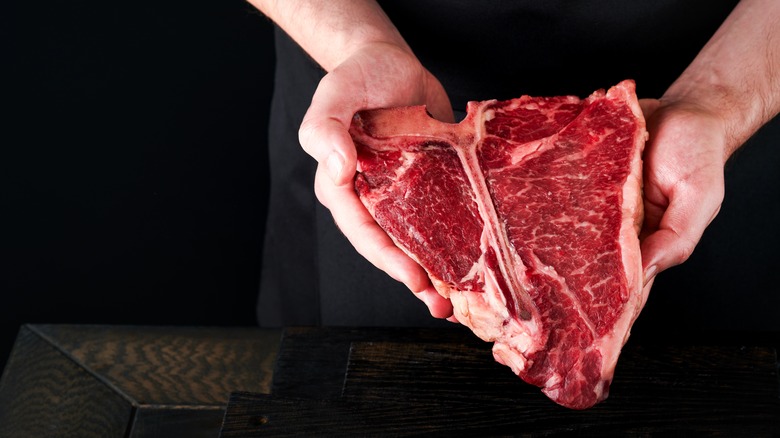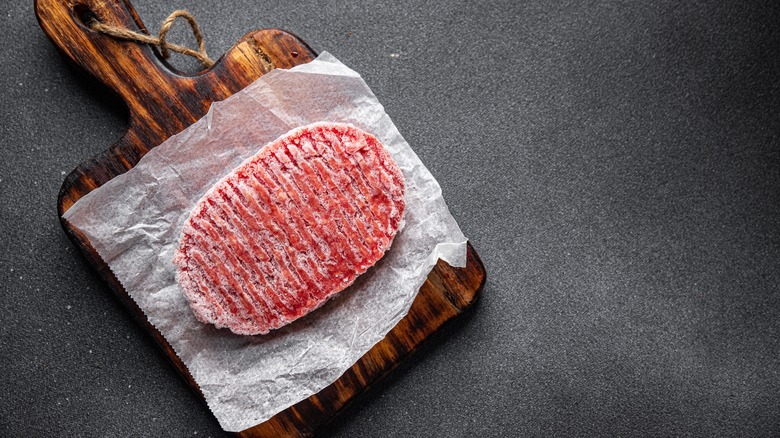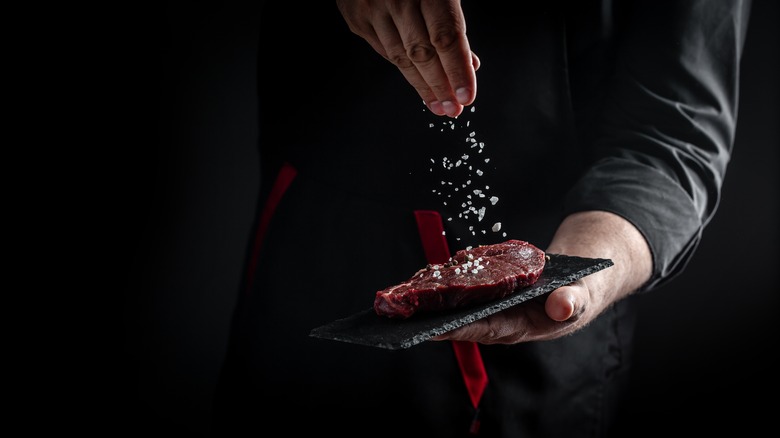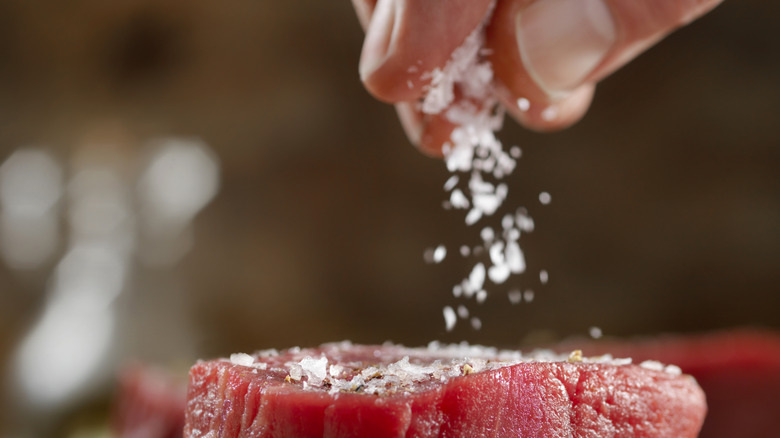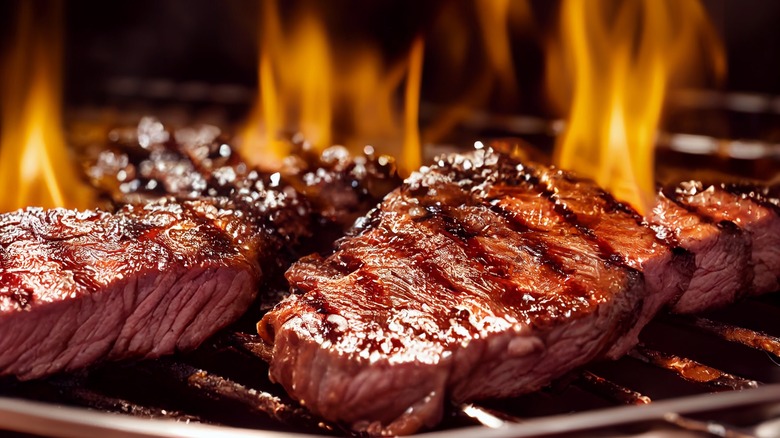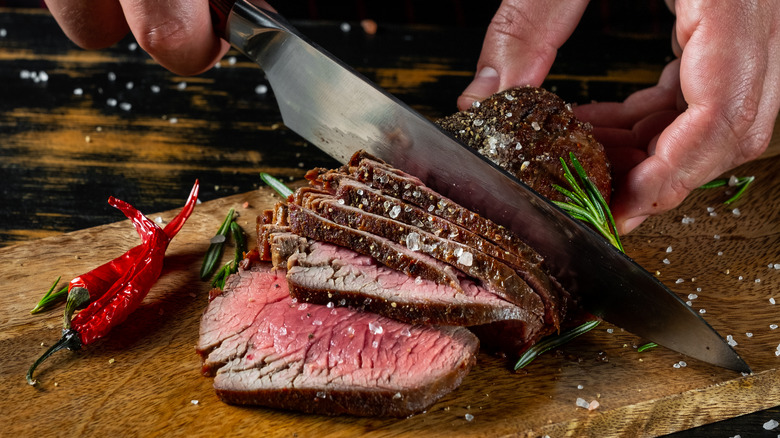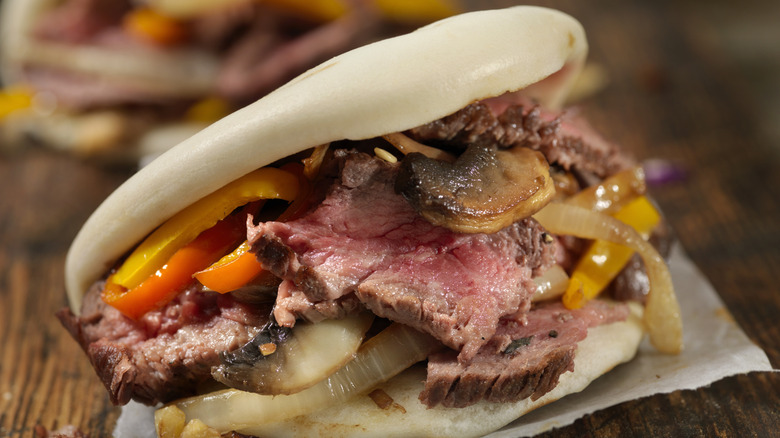10 Ways You're Ruining Expensive Cuts Of Steak
When it comes to proteins to put on your dinner table, steak is far from the cheapest of options. One of Costco's cheapest steaks — coulotte — retails for almost $20 a pound (though you may find steak for a bit cheaper at your local store). That's practically a fortune compared to chicken at nearly $13 or pork at just over $15. And it only gets more expensive from there. Dry-aged steaks regularly fetch prices of over $100 a pound, and carnivores with the funds can be found paying thousands of dollars for hibernated beef from celebrity butcher Alexandre Polmard or exquisitely marbled wagyu from Japan.
It would be a shame to ruin these top-notch steaks, but unfortunately, experts say that it's commonplace — and often at the hands of pros. "I once heard of a chef serving 'torch steak,'" says Bobby Will, chef and owner of Thistle & Grouse in Portland, Maine. "He cooked a steak to order with a butane torch like the one chefs buy at the hardware store to caramelize sugar on your creme brûlée."
But egregious errors aren't always as evident as this nightmare — and if it happens to the pros, it can definitely happen to the home cook. From improper seasoning to the wrong cooking method, it turns out it's relatively easy to mess up your steak at home. Here are some of the most important mistakes to avoid ruining that steak you've shelled out for.
1. Grinding the wrong steak into burger meat
Using great beef in burgers is a fairly divisive choice. Some experts caution against it, like Katie Flannery, co-owner of Flannery Beef, dubbing it sacrilegious to grind up spendy steaks like ribeye or filet. Justin Owens, owner of Manzo Piedmontese, agrees. "The first time I heard about people doing this was when a friend picked up some really expensive tenderloins and then told the butcher to grind them, who nearly had a heart attack upon hearing the request," he says. "And when he told me, I almost had a stroke!"
For Flannery, this is purely a waste of money. "Your average consumer would be hard pressed to tell the difference between a burger made of ground ribeye compared to one made of ground chuck eye, though the price tag would be significantly different."
This isn't to say you can't shell out for top-notch burger meat, provided you know what to ask for. Braising cuts like chuck or brisket have loads of flavor, which will come through in the final mince. Will loves using a mix of chuck, brisket, and short rib for the perfect ratio of texture and flavor in his burger patties. Paying a bit more for dry-aged prime or lusciously marbled wagyu, according to chef Michael Paley, Executive Steakhouse Chef at Prime 54, add "a great depth of flavor and umami to the burger."
2. Drowning your steak in sauce
From bearnaise to blue cheese, sauces have long littered the tables of even top steakhouses. But for our experts, most accoutrements get in the way of top-notch beef. "Some sauces can really hurt a great steak," says Guara Pimenta, Executive Chef of Vela Seaport, who notes that at his restaurant, he prefers a simple seasoning of fleur de sel and compound butter. "When you drench your steak in sauce," he says, "you lose the rich flavor of a great cut of beef."
That said, some do note that a great sauce can be a lovely accent — especially, according to Rusty Pelican Miami Executive Chef Fiorela Cornejo, when it's served on the side for dipping. "I love sauce and think it can help a steak if used the right way," she says.
For Flannery, a stronger sauce is best paired with a relatively mild steak, so as better to avoid competing flavor profiles. "If you want your sauce to be the star of your dish, make sure to pair it with a steak that will be relatively blank canvas," she says. Chef Michael Vignola, Director of Culinary at Catch Hospitality Group, uses these principles, with something like a "lean, cleaner filet," he says, gaining in umami and unctuousness with the addition of truffle butter. For Will, a relatively mild hollandaise enriches steak just enough, making it one of his go-tos, while something as powerful as sriracha "steals the show" and is, for him, a crime.
3. Overcooking your steak
By far the most egregious error cited by our pros is overcooking a good steak. "The most heinous way you can ruin an expensive steak is by ordering it well done," says Cornejo.
This, Flannery says, is due to the way in which overcooking affects the texture of the meat. "High end steaks are prized for their ability to deliver a combination of both tenderness and flavor," she says. "When you overcook a steak, you cause the muscle fibers of the meat to tighten; creating an incredibly tough end result. Since there are other cuts of steak that are inherently tender, it's blasphemous to take a tender cut and deliberately turn it tough."
Erring on the side of undercooking is best, according to Vignola. "I do not think it is possible to undercook a steak," he says. "I personally believe the redder the better, I love it raw."
But even for those who don't share Vignola's caveman tastes, the quality of the beef just shines when it's properly cooked. "The higher the quality, one can experience more layers of flavors and complexity as you bite through a great crust with a rare to medium rare interior," says Paley.
4. Undercooking steaks
Despite the egregiousness of overcooking, unless you're Vignola, undercooking a steak isn't a great idea either. "Steak tartare (raw beef) is a wonderful dish, as is a steak cooked to rare (120 degrees)," says Flannery. "The amount of people that enjoy their steaks cooked to a temperature between those two is a small crowd!"
"I don't care for black and blue," echoes Will, who notes that without the Maillard reaction (which occurs when high heat from searing or grilling caramelizes the proteins on the outside of the steak), you'd be hard-pressed to gain the rich, savory flavor you expect from a well-cooked steak. And the texture of an undercooked steak isn't ideal either; Flannery characterizes it as rubbery.
Undercooking is even worse when it comes to fattier cuts of steak, such as a ribeye or tomahawk, according to Pimenta. He maintains that these steaks demand a somewhat higher cooking temperature that will allow you to better render the fat.
That said, for Cornejo, this one ultimately comes down to personal preference. "My favorite way to cook a steak is medium rare," she says. "Some people may think that it is undercooked, and some people may think it is overcooked. It just depends on what you prefer."
5. Freezing steaks incorrectly
For some professional chefs, like Cornejo, freezing steaks is never a great idea, but others say there's a time and a place for the practice. "I would not recommend this," says Paley, "but if you are purchasing a large amount of Kobe beef, for example, and can't eat it all in one sitting, freezing it is okay as long as it is tightly wrapped."
Vignola notes that not only can freezing halt the aging process, but it can make steaks even more tender. "If done properly in cryovac and thawed properly," he says, "I do not think it is a bad idea." Emphasis on properly. "In general, freezing improves meat tenderness," echoes Flannery, noting nevertheless that other attributes, such as color stability, are negatively affected by the process.
"To keep from ruining the steak, it is important to wrap the piece of meat tightly, in a vacuum-sealed bag, to avoid freezer burn," says Pimenta, who notes that how you defrost a steak is just as important as how you freeze it. He recommends submerging the frozen steak in cold water, still in its vacuum-sealed bag. Will, meanwhile, recommends placing the bag in the fridge to let it come to temperature slowly. "Rushing it under water will cause it to lose a lot of the texture and moisture," he cautions. "DO NOT Defrost in a microwave."
6. Underseasoning steaks
Much like undercooking a steak, underseasoning it is far from the best way to let top-notch beef shine. "Under seasoned steak is bland and bland food is terrible!" says Will.
But this isn't just a question of flavor, according to Cornejo, who notes that seasoning steak with salt helps to pull out its juices and create a delicious crust. "I prefer to pull my steaks out one hour before cooking them, seasoning them with salt & pepper, and letting them come to room temp before cooking," adds Will. "It almost lightly cures the steak."
That said, if you're unsure about seasoning, it's best to err on the side of too little, according to Flannery. "An underseasoned steak will be a lackluster eating experience," she says, "but you can always add additional seasoning after cooking. Whereas if you overseason at the beginning of the cooking process, it's harder to reverse that once cooked."
7. Overseasoning steaks
While a well-seasoned steak is a delicious thing, more isn't more in this case. "There is absolutely too much of a good thing," says Flannery. "Overseasoning a steak will overpower the natural flavor of the meat and lead to an unbalanced taste."
Will says this holds particularly true with overpowering spice rubs, something he sees done all too often by many of his fellow chefs. While he's in favor of certain rubs, such as blackening spice or a classic French au poivre, taco seasoning or pastrami spice are major no-nos, especially with expensive steaks. At Vela Seaport, Pimenta explains, he relies on a simple combo of salt, pepper, and just a touch of sugar to help the steak caramelize just so. Paley keeps things even simpler, noting that crunchy salt is really all you need. "Overseasoning also comes into danger of the seasoned crust burning on the grill which will kill the taste of the meat," he says.
Even plain salt can be overdone, however, notes Vignola. "Salt is a fickle mistress," he says. Owens agrees, noting that he's noticed many diners prefer the subtle flavors of a milder-flavored meat. "Adventurous eaters may be more vocal about a flat, bland or boring taste," he says, noting that chefs and clients alike enjoy the pure beefiness of a minimally seasoned steak.
8. Not choosing the right method for a given cut of steak
The word steak encompasses a host of cuts from lean tenderloin to fatty prime rib and everything in between. With all of this variety, it should come as no surprise that each steak demands its particular brand of TLC. "A steak that's microwaved versus slowly cooked over a mesquite is going to be very different," says Vignola. "I could argue the cooking method is more important than the steak itself."
"Some cuts are best grilled, seared, and even roasted, while others must be braised!" echoes Pimenta. "So definitely choose your method of cooking before you start any prep."
For Will, flank or skirt steak demands the smokiness of a hickory wood-fueled grill or charcoal, while for filet he prefers searing the meat in a hot cast iron pan and finishing it in the oven with butter, thyme, and garlic. He takes care to baste the steak when it emerges to ensure that it's gleaming brilliantly. And at Vela Seaport, Pimenta says, "we grill skirt steak as it's one of the most flavorful cuts of beef, and it is a great steak for grilling."
9. Not resting the steak after cooking
Once you've lovingly thawed, seasoned, and cooked your top-notch steak, it would be tempting to dig right in. But despite the enticing aromas and tantalizing sizzle, attacking a fresh-off-the-grill steak with a knife is a major faux pas. By not allowing the steak to rest before cutting it, Vignola notes, you're inviting it to "bleed all over," potentially resulting in dry steak (and all your work and expense being in vain).
Instead, once your steak is finished, set it on a plate or board and cover it loosely with foil so that the juices can redistribute within the meat. Five minutes per inch of thickness or 10 minutes a pound is a great benchmark. That also gives you ample time to put the finishing touches on your side dishes like perfect Caesar salad, or to pour the red wine. At this point, it's time to slice (against the grain, of course) and dig in.
10. Neglecting your leftover steak
Steak is always at its best when fresh, but should you end up with leftovers, do not neglect them. Flannery suggests leaving any leftover steak in whole pieces and refrigerating overnight. This chilling, she says, means "it's much easier to slice into thin pieces," which Paley likes to enjoy on a salad and Flannery loves in a steak sandwich, the recipe for which couldn't be more simple: "a rustic roll, creamy horseradish aioli, crisp arugula, sliced tomatoes, melted provolone, and a drizzle of balsamic glaze."
But leftover steak doesn't always have to be eaten cold. "My personal favorite is thinly slicing and lightly reheating the steak in a pan or toaster oven," says Owens. "Depending on breakfast or lunch, I'll make a sandwich, or have it with eggs and toast."
Paley adds the idea of steak tacos, while Cornejo is a fan of using steak in empanadas. Pimenta loves transforming leftover steak into a steak and potato soup, and Will likes using it to bulk up a cold noodle salad with sesame ginger dressing. As for Vignola, the answer is clear: "Three words... PRIME RIB HASH."
